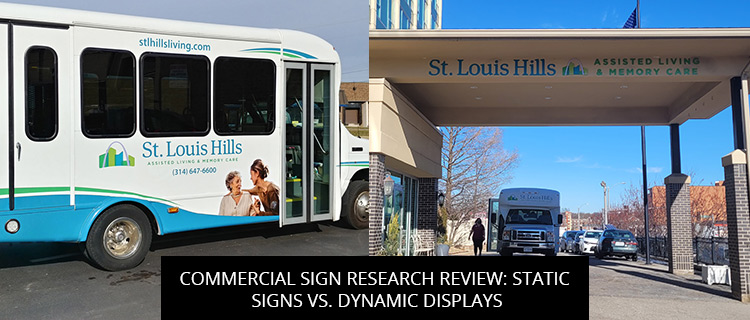Commercial Sign Research Review: Static Signs Vs. Dynamic Displays

Today’s post reviews commercial sign research comparing the effectiveness of traditional static displays and dynamic digital screens. Read on to learn what’s best for your commercial sign application, or call (314) 726-5500 to speak directly with a commercial sign specialist in St. Louis, MO.
Commercial Sign Research Review: Static Signs Vs. Dynamic Screens
Digital signs with dynamic elements, such as video, changing menus, and scrolling text, are increasingly becoming the norm in commercial sign systems in St. Louis, MO. And for good reason; according to research by the Journal of Digital Convergence, digital signs with dynamic screens:
- Increase sales volume more than any other sign types at the point of purchase
- Increase dwell time in-store, as readers linger to “search information or enjoy the [digital sign] contents” (p. 213)
- Provide excellent return-on-investment due to their easy reprogramming
Additionally, 63% of survey respondents said digital signs caught their attention better than Internet, TV, and billboard advertising (p. 213).
But dynamic signs aren’t always the answer. And in some situations, they could even stop people from engaging with your message altogether.
According to a study by the Journal of Current Issues & Research in Advertising, static commercial signs still reign supreme when it comes to advertising recall and retention. Their effectiveness has to do with message size, display time, and information load. Simply put, while dynamic screens do well at catching the eye, the sign face changes too fast for the message to really sink in.
That is both the strength and weakness of dynamic screens, and we must understand both sides of the coin in order to use them properly. Digital signs with changing elements allow owners to present a lot of information at once, which is great when you need to overview a complicated menu or tell a story. But most of these interactions occur in-store, presumably after your commercial sign has drawn the customer inside, not when they are walking or driving past your business.
Since passing drivers can only afford quick looks at your sign before putting their eyes back on the road, it may take a glance or two to take in the whole message. Large, static commercial signs encourage these double-takes and thus build deep impressions, whereas dynamic screens tell drivers not to bother, since there’s too much going on for them to take in at-a-glance, and the message will have probably changed by the time they look back.
So what’s the bottom line? Use dynamic screens to captivate in-store audiences, reduce perceived wait times, and tempt customers at the point of purchase, but stick with static commercial signs when you need your primary message to sink in.
Book A Free Commercial Sign Consultation In St. Louis, MO
To learn more about which commercial signs are best for your unique goals, call (314) 726-5500 or fill out our online contact form to request a consultation in St. Louis, MO.
References
Cho, J. Y. (2019). A Study of the Effectiveness of Digital Signage: Importance of Customized Content. Journal of Digital Convergence, 17(6), 211-217.
Osborne, A. C., & Coleman, R. (2008). Outdoor advertising recall: A comparison of newer technology and traditional billboards. Journal of Current Issues & Research in Advertising, 30(1), 13-30.
Back
